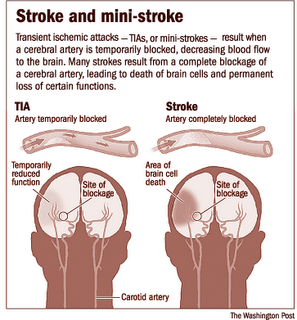Transient ischemic attack needs a new name. Its current nickname, mini-stroke, doesn’t fill the bill, either. Both suggest something small and passing, a fleeting problem you can put off until you have the time to do something about it.
What’s needed is something that conveys urgency and harm, because a transient ischemic attack (TIA) is often followed by a full-blown stroke. Getting evaluated and treated right away—within minutes of having a TIA, if possible — can lower the chances of having a stroke.
At the outset, there’s little difference between a TIA and the most common kind of stroke, an ischemic stroke. They look the same, feel the same, and are caused by the same thing — a blood clot or bit of cholesterol-filled plaque that is blocking blood flow in an artery that nourishes part of the brain.
The big thing that separates a TIA from a stroke is how long it lasts. A TIA is over quickly, often fading away within hours, if not minutes, while a stroke lasts longer than 24 hours. The blockage can cause any of the following:
• Numbness or weakness in your face, arm, or leg, especially on one side of the body.
• Inability to move your fingers, a hand, arm, or leg.
• Sudden confusion.
• Difficulty speaking or understanding what someone is saying.
• Trouble seeing with one or both eyes or hearing with one or both ears.
• Dizziness, trouble walking, or loss of balance or coordination.
• Rapid and severe headache.
In the case of a TIA, the blockage is small enough or fragile enough that the body’s self-repair systems can reopen the artery, which stops the symptoms. Larger or sturdier blockages lead to strokes.
If you are having, or have just had, a transient ischemic attack (mini-stroke), get to the hospital or call your doctor right away.
Preventing the worst
The American Heart Association and National Stroke Association offer these recommendations for preventing stroke after a transient ischemic attack:
• Rapid evaluation, preferably within 12 hours of the onset of symptoms.
• Access to same-day diagnostic imaging.
• Aggressive attention to blood pressure, cholesterol, diabetes, atrial fibrillation and other conditions.
• Control of risk factors such as smoking, obesity and physical inactivity.
• Use of aspirin, aspirin plus extended-release dipyridamole (Aggrenox), or clopidogrel (Plavix) to prevent the formation of further blood clots.
• Surgery (carotid endarterectomy) or endovascular therapy (angioplasty with or without a stent) to open a narrowed or blocked carotid artery.
Changing habits
Although it will be impossible to prevent all post-TIA strokes, we can do a lot better. But that will take work on three fronts:
• Recognition. Knowing the signs and symptoms of a TIA is the first step toward making it a truly transient problem.
• Response. If you think you or someone you are with is having a TIA or stroke, call 911 or your local emergency number right away. If it’s a stroke, getting to the hospital within 60 minutes makes you eligible to receive a clot-busting drug that can greatly reduce the damage caused by a stroke. If it’s a TIA, prompt evaluation can help prevent a stroke.
• Reorganization. So far, only a few hospitals have set up dedicated stroke centers that are able to rapidly evaluate people having TIAs and strokes. There is a movement under way to create more such centers, but it won’t happen quickly.
In the meantime, if you think you are having a TIA, or just had one, treat it like the emergency it is and get help right away. Read original article at original location here http://www.buffalonews.com/185/story/796149.html
http://stroke.about.com/od/whatisatia/a/TIAs.htm


No comments:
Post a Comment